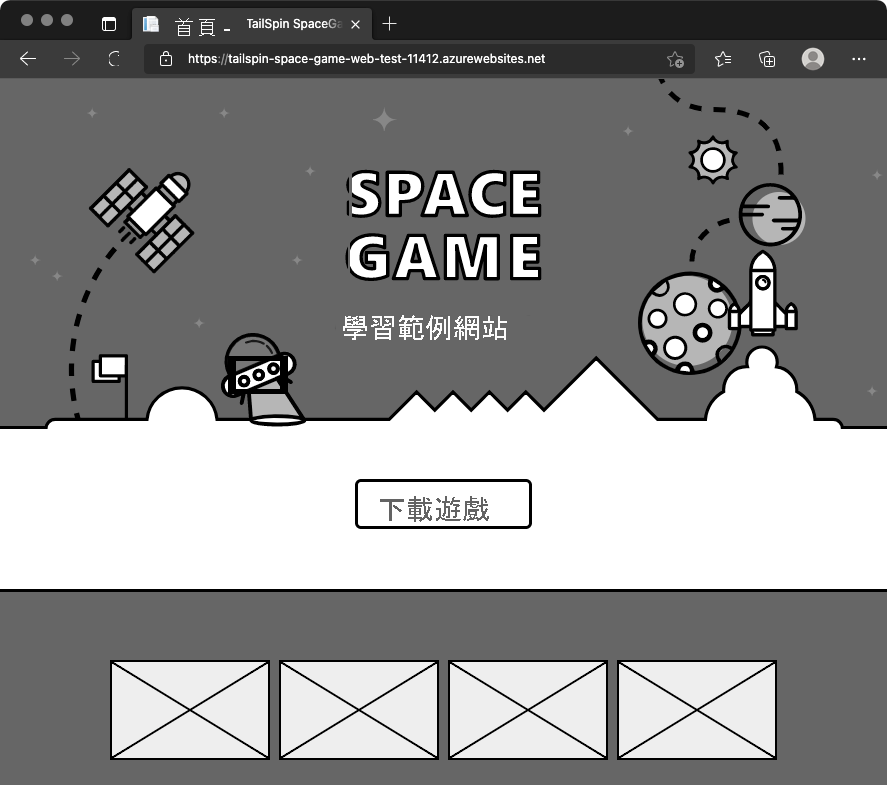練習 - 升階至測試階段
您的發行管線還是只有兩個階段,但已經變得和之前不同。 這兩個階段分別是組建和開發。 您推送至 GitHub 的每個變更都會觸發組建階段的執行。 只有在變更位於發行分支時,才會執行開發階段。 在這裡,您要將測試階段新增至管線。
回想一下,小組決定使用排定的觸發程式,將組建從開發階段升級至上午 3 點的測試階段。 若要設定已排程的觸發程序:
- 在組建設定中定義排程。
- 定義測試階段,並於其中納入條件,使該階段只會在組建原因標示為
Schedule時才執行。
為了方便學習,請在這裡定義排程,但允許組建直接從開發階段進入到測試階段。 此設定可讓您不必等候排程的觸發。 當您完成此課程模組之後,請嘗試使用不同的 cron 運算式進行實驗,以便只在排定的時間執行測試階段。
將變更升階至測試階段
在這裡,您會修改管線設定,以將組建部署到測試階段。
在 Visual Studio Code 中修改 azure-pipelines.yml,如下所示:
trigger: - '*' variables: buildConfiguration: 'Release' releaseBranchName: 'release' schedules: - cron: '0 3 * * *' displayName: 'Deploy every day at 3 A.M.' branches: include: - release always: false stages: - stage: 'Build' displayName: 'Build the web application' jobs: - job: 'Build' displayName: 'Build job' pool: vmImage: 'ubuntu-20.04' demands: - npm variables: wwwrootDir: 'Tailspin.SpaceGame.Web/wwwroot' dotnetSdkVersion: '6.x' steps: - task: UseDotNet@2 displayName: 'Use .NET SDK $(dotnetSdkVersion)' inputs: version: '$(dotnetSdkVersion)' - task: Npm@1 displayName: 'Run npm install' inputs: verbose: false - script: './node_modules/.bin/node-sass $(wwwrootDir) --output $(wwwrootDir)' displayName: 'Compile Sass assets' - task: gulp@1 displayName: 'Run gulp tasks' - script: 'echo "$(Build.DefinitionName), $(Build.BuildId), $(Build.BuildNumber)" > buildinfo.txt' displayName: 'Write build info' workingDirectory: $(wwwrootDir) - task: DotNetCoreCLI@2 displayName: 'Restore project dependencies' inputs: command: 'restore' projects: '**/*.csproj' - task: DotNetCoreCLI@2 displayName: 'Build the project - $(buildConfiguration)' inputs: command: 'build' arguments: '--no-restore --configuration $(buildConfiguration)' projects: '**/*.csproj' - task: DotNetCoreCLI@2 displayName: 'Publish the project - $(buildConfiguration)' inputs: command: 'publish' projects: '**/*.csproj' publishWebProjects: false arguments: '--no-build --configuration $(buildConfiguration) --output $(Build.ArtifactStagingDirectory)/$(buildConfiguration)' zipAfterPublish: true - publish: '$(Build.ArtifactStagingDirectory)' artifact: drop - stage: 'Dev' displayName: 'Deploy to the dev environment' dependsOn: Build condition: | and ( succeeded(), eq(variables['Build.SourceBranchName'], variables['releaseBranchName']) ) jobs: - deployment: Deploy pool: vmImage: 'ubuntu-20.04' environment: dev variables: - group: Release strategy: runOnce: deploy: steps: - download: current artifact: drop - task: AzureWebApp@1 displayName: 'Azure App Service Deploy: website' inputs: azureSubscription: 'Resource Manager - Tailspin - Space Game' appName: '$(WebAppNameDev)' package: '$(Pipeline.Workspace)/drop/$(buildConfiguration)/*.zip' - stage: 'Test' displayName: 'Deploy to the test environment' dependsOn: Dev #condition: eq(variables['Build.Reason'], 'Schedule') jobs: - deployment: Deploy pool: vmImage: 'ubuntu-20.04' environment: test variables: - group: 'Release' strategy: runOnce: deploy: steps: - download: current artifact: drop - task: AzureWebApp@1 displayName: 'Azure App Service Deploy: website' inputs: azureSubscription: 'Resource Manager - Tailspin - Space Game' appName: '$(WebAppNameTest)' package: '$(Pipeline.Workspace)/drop/$(buildConfiguration)/*.zip'schedules區段會定義一個 cron 運算式。 您可以在設定中定義多個運算式。 此運算式會在每天凌晨 3 點觸發管線,以針對發行分支來執行。always旗標會設定為false,以便讓管線只會在發行分支包含上次執行後的變更時才執行。Test階段會定義條件,以便只在組建原因等於Schedule時才開始執行。 (內建變數Build.Reason會定義組建原因。) 如果此條件為 false,則會略過此階段,但先前的階段會繼續執行。注意
會顯示此條件以方便您學習。 其已加上註解,以便讓變更可以從開發進入到測試,而不必等待排程的觸發。
在整合式終端機中,將 azure-pipelines.yml 新增至索引。 然後認可變更,並將其推送至 GitHub。
提示
執行這些 Git 命令之前,請先儲存 azure-pipelines.yml。
git add azure-pipelines.yml git commit -m "Deploy to the Test stage" git push origin release在 Azure Pipelines 中,移至該組建。 在建置執行時加以追蹤。
組建完成後,若要返回 [摘要] 頁面,請選取 [返回] 按鈕。

您會看到部署已順利完成。
從網頁瀏覽器,移至與您測試環境之 App Service 實例相關聯的 URL。
如果您的瀏覽器索引標籤仍保持開啟,請重新整理頁面。 如果您不記得 URL,請在 Azure 入口網站的 [App Service 詳細資料] 頁面中找到該 URL。
您會看到 Space Game 網站已部署至 App Service,且正在執行。

(選擇性步驟) 在 Azure Pipelines 中選取 [環境]。 然後,選取 [測試] 環境。
Azure Pipelines 會記錄您的部署歷程記錄。 在歷程記錄中,您可以透過環境中的變更逆向追蹤到程式碼認可和工作項目。

Andy 和 Mara 將測試階段新增至管線。 他們會向 Amita 顯示結果。
Amita:對於會每天早上建置和部署變更而讓我能夠進行測試,我感到非常滿意。 但我不知道要如何控制變更抵達預備環境的時間。
Mara: 是,透過自動化部署可節省大量時間。 請記住,我們只納入了已排程的觸發程序。 當我們設定 Tim 的 預備 環境時,讓我們為您新增發行核准。 如此一來,變更只會在您準備好時移至 預備 環境。